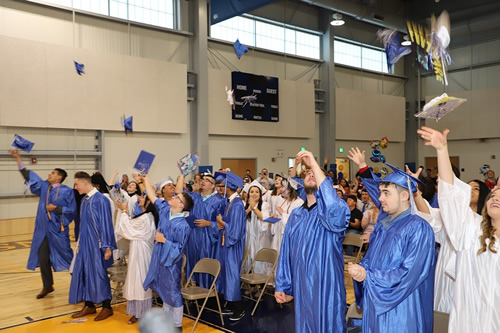High school graduation is one of the big milestones of life. Regardless of the destination, the transition is a major one. To ensure the transition is successful, schools must work to give their students the skills and knowledge they will need when they enter college or the 21st-century workplace.
At Atlantis Charter School in Fall River, Massachusetts, we are taking an innovative approach toward education to help ensure that happens. Working with a coalition of partners from higher education, business, and industry, we designed a high school curriculum that addresses the growing skills gap that exists in education today so that students are prepared for what is expected of them in college and beyond. The cornerstone of our high school is five school-to-career academies. They are:
- STEM
- Health, Med-Tech & Sports Medicine
- Arts, Culture & Design
- Teacher Development
- Business and Entrepreneurship
How our Career Academies work
The Career Academies are not vocational schools. The classes are taught along with a traditional college-preparatory curriculum, including honors and advanced placement classes. Freshmen and sophomores get an introduction to each academy, and they choose one track for their junior and senior years.
In the academies, students learn by doing. Each academy is designed to give students a hands-on educational experience. Take our Health, Med-Tech & Sports Medicine Academy as an example. A portion of the class is dedicated to instructional time, but students then practice what they just learned on a robotic SimMan. It’s a realistic, adult-sized, wireless patient simulator that teaches students about airway, breathing, cardiac and circulation management. We found the technology on a visit to Harvard Medical School and it was a perfect tool to give our students an advantage as they prepare to enter the medical field.
In addition to classroom learning, our coalition partners welcome our students to their campuses and businesses for job shadowing. Students in the Arts, Culture and Design Academy recently toured the world-class facilities at Berklee College of Music in Boston. The visit was arranged by Prince Charles Alexander, an award-winning record producer and former recording artist who is a professor of music production at Berklee and also serves as an adviser to Atlantis.
Students explored various principles of acoustics, recording equipment and production techniques. They got to see what it would be like to be a student at Berklee. Field trips like this one give our students the opportunity to see how what they are studying in school can be applied to a future job.
Our seniors are also required to complete an internship. These internships give students another opportunity to apply what they learn in class to real-life situations. Students in the Business Academy were assigned to internships that best matched their career interests. For example, one student was placed at the Fall River District courthouse while another did an internship at the local newspaper.
Community connections
We partner with local businesses and higher education institutions to show students what opportunities are available to them close to home. These partnerships provide our students with an immediate outlet if they wish to pursue these careers or college majors after they graduate from our program. Many young people leave the region after high school because they do not see a pathway to the competitive careers that they are seeking. But those careers do exist, and we believe that by showing students the pathways available we can support economic development in the region.
One of our partners is the Business Innovation Center (BIC) in Fall River. The BIC was founded by Chris Nielsen, a local entrepreneur and an instructor in our Business and Entrepreneurship Academy. The BIC fosters innovation and creativity through shared workspaces and makerspaces. Nielsen has hosted workshops for Atlantis students at the BIC and is working to create internships at the site for seniors in the Business Academy next spring.
Teachers and class structure
We wanted the academies to reflect a college campus environment. Academy classes are taught by adjunct instructors who are seasoned veterans at the business level and at the higher ed level, and they bring a tremendous amount of experience to our program. Some are retired, but many are still practicing in their chosen field. Our adjunct instructors know the ins and outs of their respective fields, and they are eager to share their knowledge with the next generation.
The physical model for the academies is the open-concept design of the modern workplace. Walk into one of the classes of our business entrepreneurship academy and you’ll find students at work in every corner of the room, some meeting in small groups. This is all in the interest of autonomy and flexibility, in keeping with the freedom that charter schools enjoy in contrast to public schools in the district.
The future
Our Career Academy model is still new. This spring, we graduated our first high school class, a group of 40 young men and women who boast a remarkable statistic: 100 percent will be attending college in the fall. We intend to chart their path and study what worked and what did not. Armed with that knowledge, we can make changes as needed so that we can continue to refine and improve our model. This approach is still in its infancy, but we hope that it is one others will someday replicate across the country to help students prepare for challenges of the future.
- Motivating students using the Self-Determination Theory - April 17, 2024
- Michigan Virtual’s statewide workgroup releasing AI guidance for K-12 educators - April 17, 2024
- 5 obstacles AI can help schools overcome - April 16, 2024

